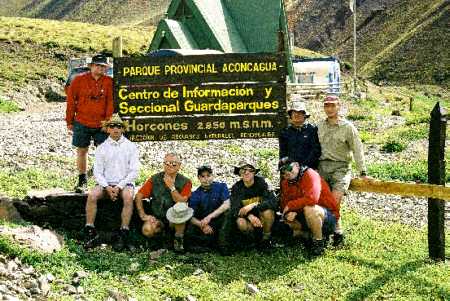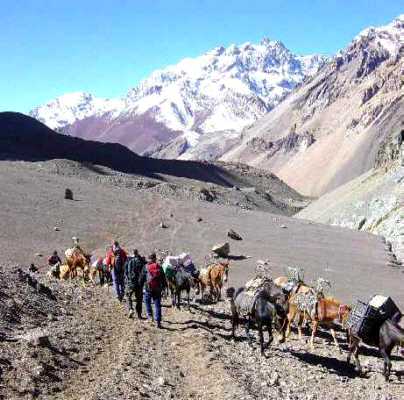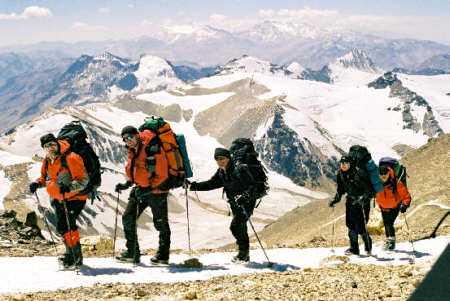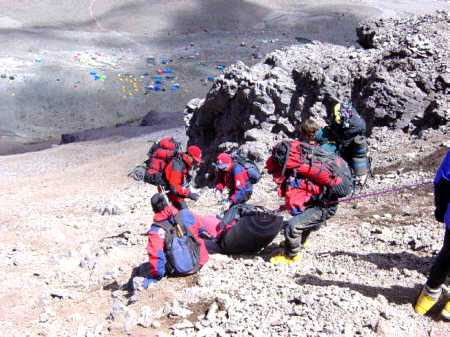Mountaineering Expedition ‘Northern Horcones 04’ - Argentina, Feb 2004
103rd (The Lancashire Artillery Volunteers) Regiment RA(V)
Arriving in the summer heat of Buenos Aries, we looked forward to a challenging high altitude mountaineering experience on Mount Aconcagua. What we did not expect was to find ourselves involved in the life or death rescue of one of our expedition members, struck down with a cerebral oedema as we attempted to summit 2 weeks later.
On 8th February 2004 the main body arrived in the capital city of Argentina en route for Mendosa. The expedition comprised 8 mountaineers 6 of whom had altitude experience and 2 relative novices. Unusually, the average age of the expedition members was 41, with 32 years difference between the oldest and youngest participants! Following a couple of days of administration and wine tasting in Mendosa we found ourselves in Puente del Inca ready to start our walk-in to Aconcagua. One of the great advantages of climbing in this part of the world is the availability of mules for load carrying to Base Camp, so we happily off-loaded 240 kgs of rations and high altitude clothing onto the mules and set off up the hill on light scales.
 Group shot - Park entrance |
After 3 days walking we arrived at Base Camp. Otherwise known as Plas de Mulas, Base Camp is at 4300m and is a collection of trekking company tents, tea shacks, bars (!) and even a Doctor’s tent. Those that had mistakenly gone ‘extra light’ for the walk in and had put their down sleeping bags on the mules were especially glad to be reunited with their kit; they had endured 3 unusually frosty nights sleeping only in their bivvy bags on the walk in. Base Camp also featured a hot shower, which some of us took advantage of, after all, anyone can be uncomfortable. Acclimatisation can be monitored so each day we checked in with the Doctor to have our blood oxygen saturation checked (a free service offered by the Parks). A reading of over 85% O2 saturation at Base Camp indicates that an individual should cope further up the mountain; after 3 days and 4 nights in Base Camp we were ready for the high mountain. Employing the usual system of load carrying, we ascended systematically up through Camp Canada (4900m) and Nido de Condores (5650m)arriving, at White Rocks 6030m our pre summit Camp on the evening of 20 February 2004. The weather forecast was unsettled, but we fortunately arrived at our pre summit camp in the middle of a good weather window. Morale was high, the whole team appeared fit and we were ready for our first crack at the summit the following morning. As we closed down for the night we were treated to a brilliant night sky without a breath of wind. Everything seemed set for the following morning. The first sound that greeted us on that beautiful morning was the sound of someone retching. Involuntary vomiting at altitude is not that unusual, and in the absence of any other symptoms is not a huge issue. However on this occasion it signalled serious trouble in WO2 Carl Smith’s tent. Immediately after retching he became comatose and was displaying all the classic signs of High Altitude Cerebral Oedema. (HACE). HACE is the most life threatening version of Altitude Mountain Sickness and without rapid treatment can be fatal. Normally with HACE the climber displays various symptoms before slipping into a coma. Thereafter it is just a matter of time. WO2 Smith had apparently slept through all but the final symptom and it was clear that we now had a major problem on our hands and that time was very short if we were to save his life. Using a Sat phone we raised the Park Rangers to arrange helicopter evacuation. Despite clear weather at 6000m, the Argentine Air Force helicopter was weathered in at the Park entrance 2300m lower down and there would be no flying that morning. (Lesson 1 – never rely on helicopters). LCpl Ru Hill, our exped medic, administered Dexamethasone orally and got WO2 Smith ready for evacuation whilst we built a rope stretcher. At this stage WO2 Smith was 13 stone of dead weight and had to be manhandled out of his tent and onto the stretcher. Other climbers at White Rocks lent a hand where they could, including a doctor who checked WO2 Smith’s blood saturation level (40% and falling) and administered more Dexamethasone intramuscularly. The race was now on to get the casualty down the mountain to safety as quickly as possible. His chances of survival would improve with every metre of descent. For 200 metres we carried WO2 Smith by rope stretcher down to a more level area and transferred him to an improvised litter brought up from Berlin Camp 150 metres beneath us. (Lesson 2 – never underestimate the physical demands of carrying a casualty – at least 6 fit climbers are required in rotation and more over difficult terrain). The new litter comprised 2 half barrels, in which the casualty could be secured and which we could drag across the scree, so now we were able to move much more quickly. The litter was dragged, thrown, dropped and otherwise propelled down the mountain. Our descent at times was reckless but speed was everything and as WO2 Smith was still unconscious so he couldn’t complain! 300 metres below White Rocks we were joined by 2 Argentine Mountain Rescuers who helped with the litter. At Nido de Condores (5650m) it became apparent that the helicopter was still not flying so after receiving a check up from another doctor and hooking WO2 Smith up to an oxygen bottle we were on our way again. More Mountain Rescue staff lent a hand and after 4 ½ hours we finally arrived at Base Camp and the stretcher race was officially over. WO2 Smith was more or less conscious for the final hour of the descent and complained about being too warm and back pain so we knew he was going to be OK! At Base Camp WO2 Smith was sufficiently recovered to walk supported, to the Base Camp Doctor who took over and confirmed our HACE diagnosis but added Pulmonary Oedema to the list. It had been a close run thing. |
 Mules in Horcones Valley |
|
 Approaching Camp Berlin 6000m |
|
 Stretcher on steep ground |
WO2 Smith was eventually evacuated by mule that afternoon to the Park entrance. He was accompanied all the way (on foot) by Captain Ian Blackwood and LCpl Ru Hill who stuck with him for the 7 hour walk out (lest he fell off the mule) to the Park entrance; a sterling effort considering they had both been very involved in the CASEVAC from White rocks to Base Camp. Following a 4 hour transfer by car, WO2 Smith eventually arrived at Mendosa Hospital arriving at 4 am - 19 hours after the CASEVAC had started.
WO2 Carl Smith stayed in hospital in Mendosa for 3 days and has now made a full recovery. The rescue had involved approximately 27 people including 3 doctors and the muleteer. The Mountain Rescue team were first class as were the Argentinean Army who provided a senior NCO to escort the mule party.
Five of us waved goodbye to WO2 Smith as he embarked on his 7 hour mule ride down the Horcones Valley; a fitting farewell for an RHA soldier! The immediate problem now was that we had no kit with us at Base Camp. In the rush to evacuate the casualty we had left our tents and sleeping bags at White Rocks at 6000m (3 days climb above us) and only had the kit we were standing up in or had thrown into our bergans for the rescue effort. Returning to White Rocks to recover our kit was now our first priority and would clearly have to be achieved in a ‘oner’ but would have to wait until we had recovered. Having reached White Rocks, and if the weather was right perhaps we might have another go at the summit ... but that’s another story.